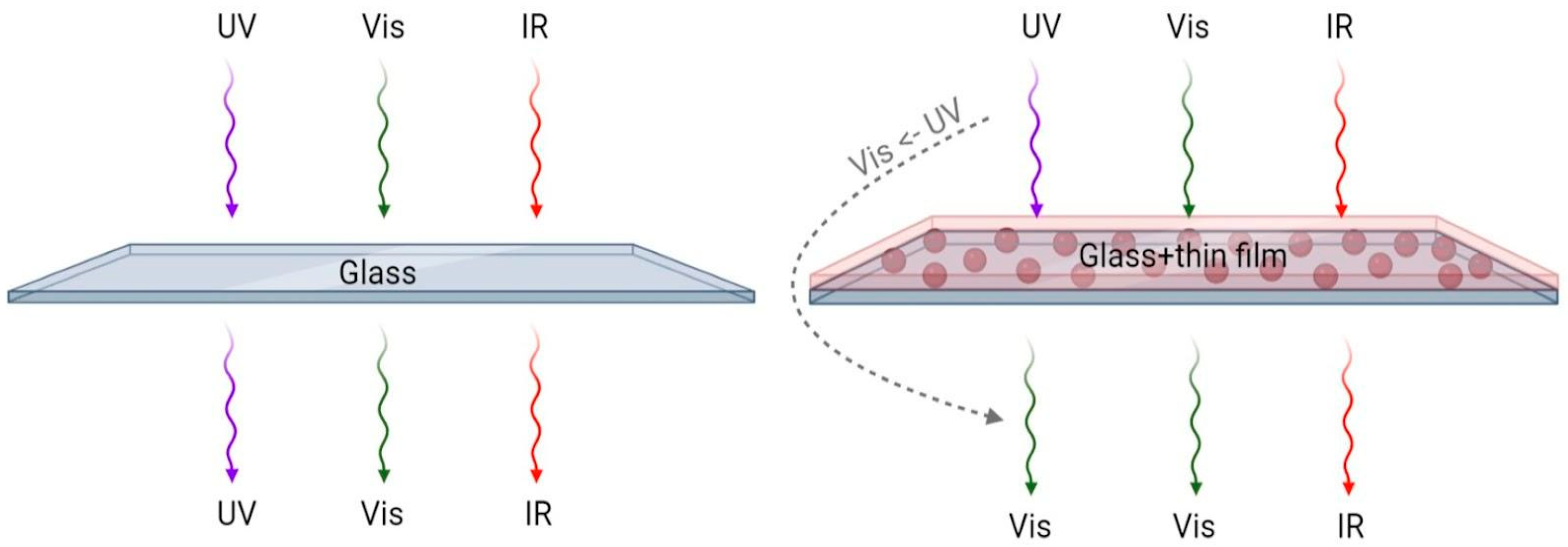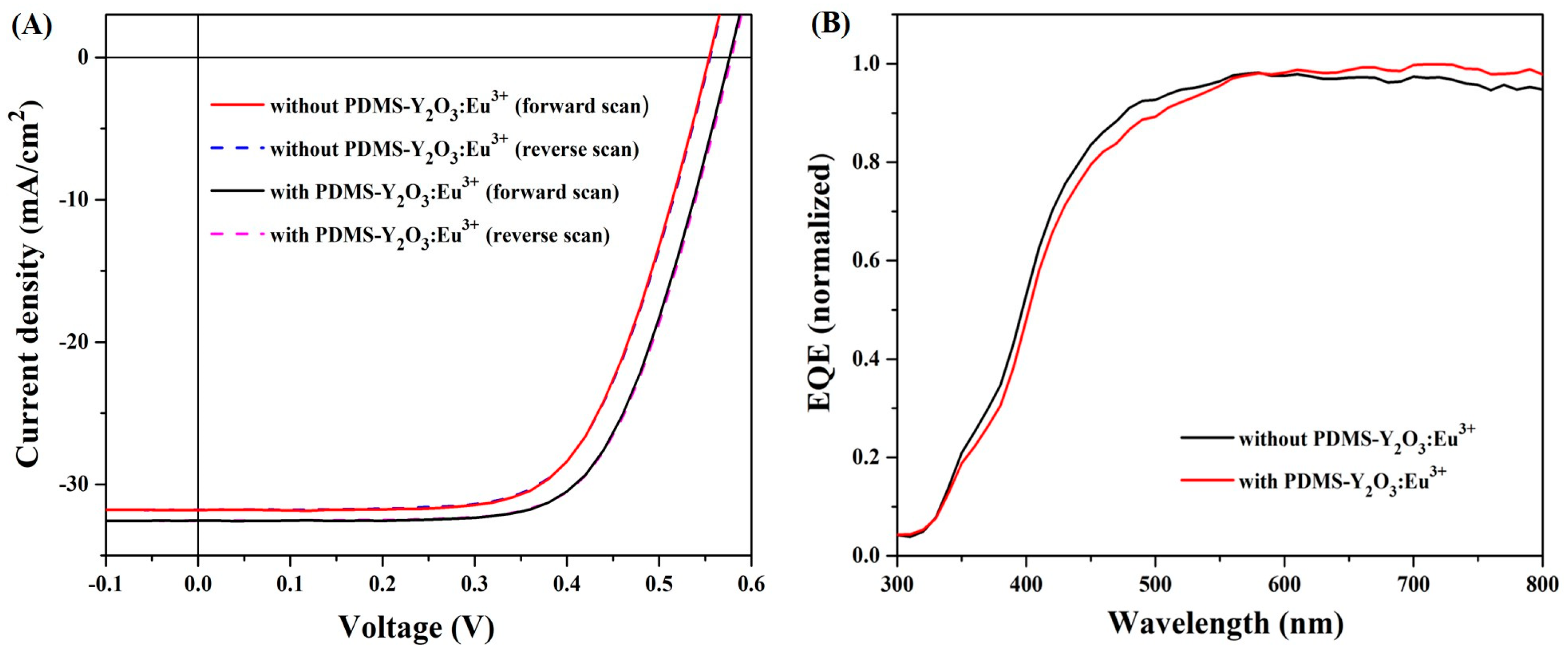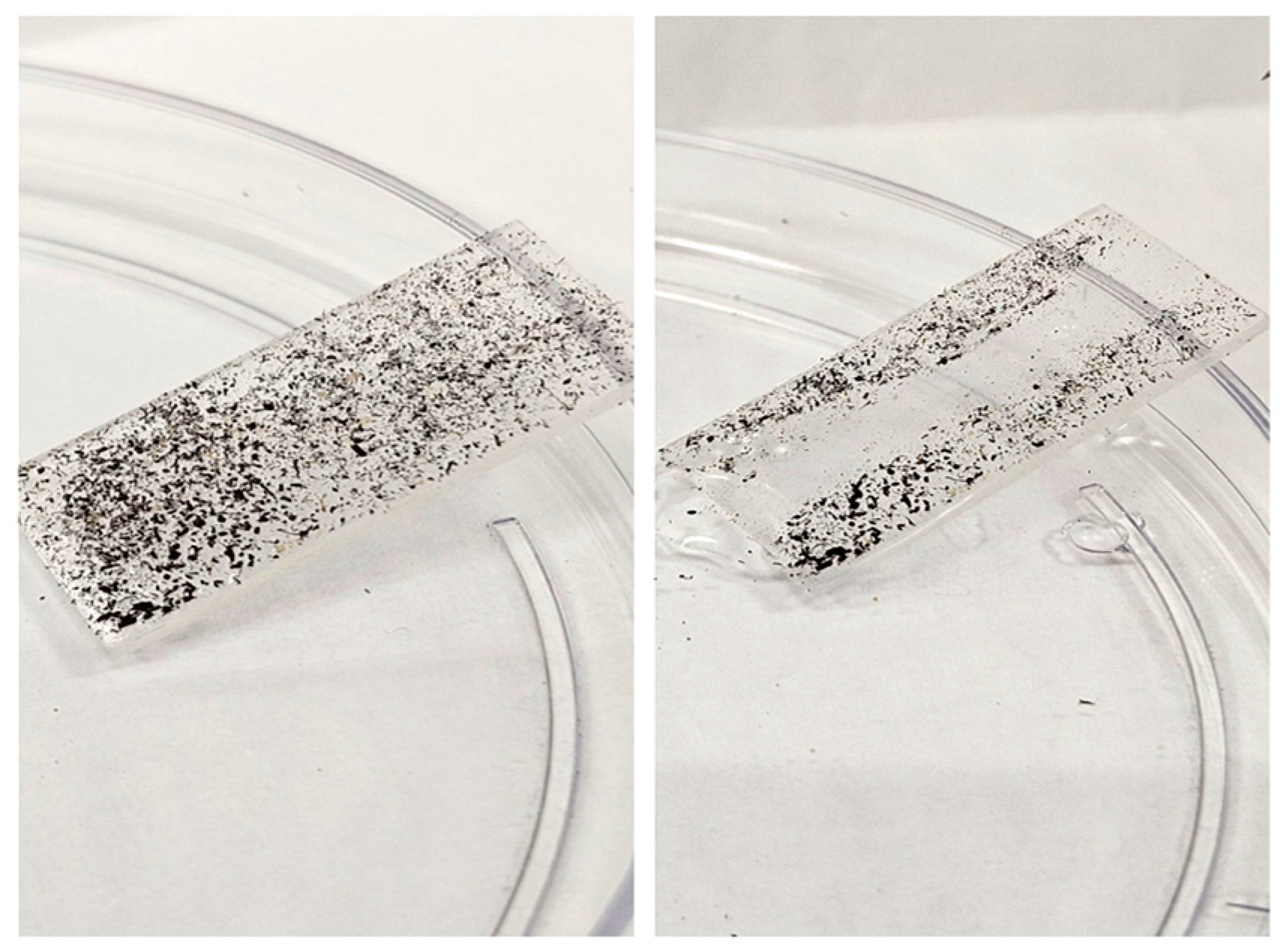Hydrophobic and Luminescent Polydimethylsiloxane PDMS-Y2O3:Eu3+ Coating for Power Enhancement and UV Protection of Si Solar Cells
Abstract
1. Introduction
2. Materials and Methods
2.1. Synthesis of Y2O3:Eu3+ Particles
2.2. PDMS-Y2O3:Eu3+ Coating Deposition
2.3. Characterization
3. Results and Discussion
4. Conclusions
Supplementary Materials
Author Contributions
Funding
Data Availability Statement
Acknowledgments
Conflicts of Interest
References
- Saga, T. Advances in Crystalline Silicon Solar Cell Technology for Industrial Mass Production. NPG Asia Mater. 2010, 2, 96–102. [Google Scholar] [CrossRef]
- Battaglia, C.; Cuevas, A.; De Wolf, S. High-Efficiency Crystalline Silicon Solar Cells: Status and Perspectives. Energy Environ. Sci. 2016, 9, 1552–1576. [Google Scholar] [CrossRef]
- Andreani, L.C.; Bozzola, A.; Kowalczewski, P.; Liscidini, M.; Redorici, L. Silicon Solar Cells: Toward the Efficiency Limits. Adv. Phys. X 2018, 4, 1548305. [Google Scholar] [CrossRef]
- Addie, A.J.; Ismail, R.A.; Mohammed, M.A. Amorphous Carbon Nitride Dual-Function Anti-Reflection Coating for Crystalline Silicon Solar Cells. Sci. Rep. 2022, 12, 9902. [Google Scholar] [CrossRef] [PubMed]
- Spence, M.; Hammond, R.; Pockett, A.; Wei, Z.; Johnson, A.; Watson, T.; Carnie, M.J. A Comparison of Different Textured and Non-Textured Anti-Reflective Coatings for Planar Monolithic Silicon-Perovskite Tandem Solar Cells. ACS Appl. Energy Mater. 2022, 5, 5974–5982. [Google Scholar] [CrossRef]
- Lindroos, J.; Savin, H. Review of Light-Induced Degradation in Crystalline Silicon Solar Cells. Sol. Energy Mater. Sol. Cells 2016, 147, 115–126. [Google Scholar] [CrossRef]
- Perrakis, G.; Tasolamprou, A.C.; Kenanakis, G.; Economou, E.N.; Tzortzakis, S.; Kafesaki, M. Ultraviolet Radiation Impact on the Efficiency of Commercial Crystalline Silicon-Based Photovoltaics: A Theoretical Thermal-Electrical Study in Realistic Device Architectures. OSA Contin. 2020, 3, 1436. [Google Scholar] [CrossRef]
- Sinha, A.; Qian, J.; Moffitt, S.L.; Hurst, K.; Terwilliger, K.; Miller, D.C.; Schelhas, L.T.; Hacke, P. UV-induced Degradation of High-efficiency Silicon PV Modules with Different Cell Architectures. Prog. Photovolt. Res. Appl. 2022, 31, 36–51. [Google Scholar] [CrossRef]
- Johansson, W.; Peralta, A.; Jonson, B.; Anand, S.; Österlund, L.; Karlsson, S. Transparent TiO2 and ZnO Thin Films on Glass for UV Protection of PV Modules. Front. Mater. 2019, 6, 259. [Google Scholar] [CrossRef]
- Yousefi, F.; Mousavi, S.B.; Heris, S.Z.; Naghash-Hamed, S. UV-Shielding Properties of a Cost-Effective Hybrid PMMA-Based Thin Film Coatings Using TiO2 and ZnO Nanoparticles: A Comprehensive Evaluation. Sci. Rep. 2023, 13, 7116. [Google Scholar] [CrossRef]
- Hong, M.; Xuan, T.; Liu, J.; Jiang, Z.; Chen, Y.; Chen, X.; Li, H. Air-Exposing Microwave-Assisted Synthesis of CuInS2/ZnS Quantum Dots for Silicon Solar Cells with Enhanced Photovoltaic Performance. RSC Adv. 2015, 5, 102682–102688. [Google Scholar] [CrossRef]
- Xuan, T.-T.; Liu, J.-Q.; Li, H.-L.; Sun, H.-C.; Pan, L.; Chen, X.-H.; Sun, Z. Microwave Synthesis of High Luminescent Aqueous CdSe/CdS/ZnS Quantum Dots for Crystalline Silicon Solar Cells with Enhanced Photovoltaic Performance. RSC Adv. 2015, 5, 7673–7678. [Google Scholar] [CrossRef]
- Du, P.; Lim, J.H.; Leem, J.W.; Cha, S.M.; Yu, J.S. Enhanced Photovoltaic Performance of Dye-Sensitized Solar Cells by Efficient Near-Infrared Sunlight Harvesting Using Upconverting Y2O3:Er3+/Yb3+ Phosphor Nanoparticles. Nanoscale Res. Lett. 2015, 10, 321. [Google Scholar] [CrossRef] [PubMed]
- Lee, S.; Kim, C.U.; Bae, S.; Liu, Y.; Noh, Y.I.; Zhou, Z.; Leu, P.W.; Choi, K.J.; Lee, J. Improving Light Absorption in a Perovskite/Si Tandem Solar Cell via Light Scattering and UV-Down Shifting by a Mixture of SiO2 Nanoparticles and Phosphors. Adv. Funct. Mater. 2022, 32, 2204328. [Google Scholar] [CrossRef]
- Sekar, R.; Ravitchandiran, A.; Angaiah, S. Recent Advances and Challenges in Light Conversion Phosphor Materials for Third-Generation Quantum-Dot-Sensitized Photovoltaics. ACS Omega 2022, 7, 35351–35360. [Google Scholar] [CrossRef]
- Trupke, T.; Green, M.A.; Würfel, P. Improving Solar Cell Efficiencies by Down-Conversion of High-Energy Photons. J. Appl. Phys. 2002, 92, 1668–1674. [Google Scholar] [CrossRef]
- Cui, J.; Li, P.; Chen, Z.; Cao, K.; Li, D.; Han, J.; Shen, Y.; Peng, M.; Fu, Y.Q.; Wang, M. Phosphor Coated NiO-Based Planar Inverted Organometallic Halide Perovskite Solar Cells with Enhanced Efficiency and Stability. Appl. Phys. Lett. 2016, 109, 171103. [Google Scholar] [CrossRef]
- Lopez-Delgado, R.; Zhou, Y.; Zazueta-Raynaud, A.; Zhao, H.; Pelayo, J.E.; Vomiero, A.; Álvarez-Ramos, M.E.; Rosei, F.; Ayon, A. Enhanced Conversion Efficiency in Si Solar Cells Employing Photoluminescent Down-Shifting CdSe/CdS Core/Shell Quantum Dots. Sci. Rep. 2017, 7, 14104. [Google Scholar] [CrossRef]
- Zhou, D.; Liu, D.; Pan, G.; Chen, X.; Li, D.; Xu, W.; Bai, X.; Song, H. Cerium and Ytterbium Codoped Halide Perovskite Quantum Dots: A Novel and Efficient Downconverter for Improving the Performance of Silicon Solar Cells. Adv. Mater. 2017, 29, 1704149. [Google Scholar] [CrossRef]
- Yang, D.; Liang, H.; Liu, Y.; Hou, M.; Kan, L.; Yang, Y.; Zang, Z. A Large-Area Luminescent Downshifting Layer Containing an Eu3+ Complex for Crystalline Silicon Solar Cells. Dalton Trans. 2020, 49, 4725–4731. [Google Scholar] [CrossRef]
- Yang, J.W.; Kim, D.I.; Jeong, R.H.; Park, S.; Boo, J. Enhancement of Perovskite Solar Cell Performance by External Down-conversion of Eu-complex Film. Int. J. Energy Res. 2022, 46, 7996–8006. [Google Scholar] [CrossRef]
- Atabaev, T.S.; Thi Vu, H.H.; Kim, H.-K.; Hwang, Y.-H. The Optical Properties of Eu3+ and Tm3+ Codoped Y2O3 Submicron Particles. J. Alloys Compd. 2012, 525, 8–13. [Google Scholar] [CrossRef]
- Atabaev, T.S.; Shin, Y.; Song, S.-J.; Han, D.-W.; Hong, N. Toxicity and T2-Weighted Magnetic Resonance Imaging Potentials of Holmium Oxide Nanoparticles. Nanomaterials 2017, 7, 216. [Google Scholar] [CrossRef]
- Chávez-García, D.; Sengar, P.; Juárez-Moreno, K.; Flores, D.L.; Calderón, I.; Barrera, J.; Hirata, G.A. Luminescence Properties and Cell Uptake Analysis of Y2O3:Eu, Bi Nanophosphors for Bio-Imaging Applications. J. Mater. Res. Technol. 2021, 10, 797–807. [Google Scholar] [CrossRef]
- Yang, J.; Fang, M.; Li, Z. Organic Luminescent Materials: The Concentration on Aggregates from Aggregation-induced Emission. Aggregate 2020, 1, 6–18. [Google Scholar] [CrossRef]
- Fang, M.-H.; Bao, Z.; Huang, W.-T.; Liu, R.-S. Evolutionary Generation of Phosphor Materials and Their Progress in Future Applications for Light-Emitting Diodes. Chem. Rev. 2022, 122, 11474–11513. [Google Scholar] [CrossRef]
- Thi Vu, H.H.; Atabaev, T.S.; Ahn, J.Y.; Dinh, N.N.; Kim, H.-K.; Hwang, Y.-H. Dye-Sensitized Solar Cells Composed of Photoactive Composite Photoelectrodes with Enhanced Solar Energy Conversion Efficiency. J. Mater. Chem. A 2015, 3, 11130–11136. [Google Scholar] [CrossRef]
- Minemoto, T.; Mizuta, T.; Takakura, H.; Hamakawa, Y. Antireflective Coating Fabricated by Chemical Deposition of ZnO for Spherical Si Solar Cells. Sol. Energy Mater. Sol. Cells 2007, 91, 191–194. [Google Scholar] [CrossRef]
- Deibel, C. Photocurrent Generation in Organic Solar Cells. Semicond. Semimet. 2011, 85, 297–330. [Google Scholar] [CrossRef]
- He, Y.; Liu, J.; Sung, S.-J.; Chang, C. Downshifting and Antireflective Thin Films for Solar Module Power Enhancement. Mater. Des. 2021, 201, 109454. [Google Scholar] [CrossRef]
- Lin, H.; Wang, G.; Su, Q.; Han, C.; Xue, C.; Yin, S.; Fang, L.; Xu, X.; Gao, P. Unveiling the Mechanism of Attaining High Fill Factor in Silicon Solar Cells. Prog. Photovolt. Res. Appl. 2024, in press. [CrossRef]
- Saloux, E.; Teyssedou, A.; Sorin, M. Explicit Model of Photovoltaic Panels to Determine Voltages and Currents at the Maximum Power Point. Sol. Energy 2011, 85, 713–722. [Google Scholar] [CrossRef]
- Tu, Y.; Tan, X.; Yang, X.; Qi, G.; Yan, K.; Kang, Z. Antireflection and Radiative Cooling Difunctional Coating Design for Silicon Solar Cells. Opt. Express 2023, 31, 22296. [Google Scholar] [CrossRef] [PubMed]
- Pascual, J.; Martinez-Moreno, F.; García, M.; Marcos, J.; Marroyo, L.; Lorenzo, E. Long-term Degradation Rate of Crystalline Silicon PV Modules at Commercial PV Plants: An 82-MWp Assessment over 10 Years. Prog. Photovolt. Res. Appl. 2021, 29, 1294–1302. [Google Scholar] [CrossRef]








Disclaimer/Publisher’s Note: The statements, opinions and data contained in all publications are solely those of the individual author(s) and contributor(s) and not of MDPI and/or the editor(s). MDPI and/or the editor(s) disclaim responsibility for any injury to people or property resulting from any ideas, methods, instructions or products referred to in the content. |
© 2024 by the authors. Licensee MDPI, Basel, Switzerland. This article is an open access article distributed under the terms and conditions of the Creative Commons Attribution (CC BY) license (https://creativecommons.org/licenses/by/4.0/).
Share and Cite
Goponenko, D.; Zhumanova, K.; Shamarova, S.; Yelzhanova, Z.; Ng, A.; Atabaev, T.S. Hydrophobic and Luminescent Polydimethylsiloxane PDMS-Y2O3:Eu3+ Coating for Power Enhancement and UV Protection of Si Solar Cells. Nanomaterials 2024, 14, 674. https://doi.org/10.3390/nano14080674
Goponenko D, Zhumanova K, Shamarova S, Yelzhanova Z, Ng A, Atabaev TS. Hydrophobic and Luminescent Polydimethylsiloxane PDMS-Y2O3:Eu3+ Coating for Power Enhancement and UV Protection of Si Solar Cells. Nanomaterials. 2024; 14(8):674. https://doi.org/10.3390/nano14080674
Chicago/Turabian StyleGoponenko, Darya, Kamila Zhumanova, Sabina Shamarova, Zhuldyz Yelzhanova, Annie Ng, and Timur Sh. Atabaev. 2024. "Hydrophobic and Luminescent Polydimethylsiloxane PDMS-Y2O3:Eu3+ Coating for Power Enhancement and UV Protection of Si Solar Cells" Nanomaterials 14, no. 8: 674. https://doi.org/10.3390/nano14080674
APA StyleGoponenko, D., Zhumanova, K., Shamarova, S., Yelzhanova, Z., Ng, A., & Atabaev, T. S. (2024). Hydrophobic and Luminescent Polydimethylsiloxane PDMS-Y2O3:Eu3+ Coating for Power Enhancement and UV Protection of Si Solar Cells. Nanomaterials, 14(8), 674. https://doi.org/10.3390/nano14080674








